 The Throws of Winter
The Throws of Winter
From a blurb for “Dikeou Superstars: Lawrence Seward” at zingmagazine‘s spinoff site, the Dikeou Collection: “We are now officially in the throws of winter.” Indeed we are. Unless I keep them cupboard my earlobs could get frostbeaten. I hear on the noose that the pitch trees down souse have loft all their believes. Gives me southpaws, let me till you. Makes me yearn for the worm weather to come, watching the hurls in their simmer tresses. [Note, February 20: I give the last word to Kanye West: “[T]here is only one thrown and that’s God’s.”]
Speaking of which: Winter has in fact arrived here, late but full force. On Sunday, January 3, I took Billie the Bengal out to back garden for a walk with me in my hoodie, perfectly comfortable for both of us. On Monday the 4th, when I stepped out the front door to run some errands, my breath frosted, and a blast of cold air slapped my face so hard I could feel my skin contracting.
They Demand Popcorn

Praying mantis with 3D glasses, courtesy Newcastle University
We have praying mantises in our garden, so this headline definitely intrigued me: “Praying mantises watch movies while wearing tiny 3-D glasses.” Seems mantises have stereo vision, and love to watch 1950s Hollywood flicks about alien invaders.
Well, I lied about the last part. But they do have stereo vision. And they do enjoy watching stereo movies about bugs. Next stop, Google Cardboard.
Another World Heard From
What do we want creatures from a distant planet, solar system, galaxy, or universe to know about us? For one answer, dating from 1977, we can turn to the “golden records” created by a committee headed by the late Carl Sagan, astronomer and science popularizer. Mounted on the outside of Voyager 1 and Voyager 2, these records contain a sampling of earthling output etched into copper LP records, including:
- 116 images encoded in analog form depicting scientific knowledge, human anatomy, human endeavors, and the terrestrial environment.
- Spoken greetings in more than 50 languages.
- A compilation of sounds from Earth.
- Nearly 90 minutes of music from around the world.
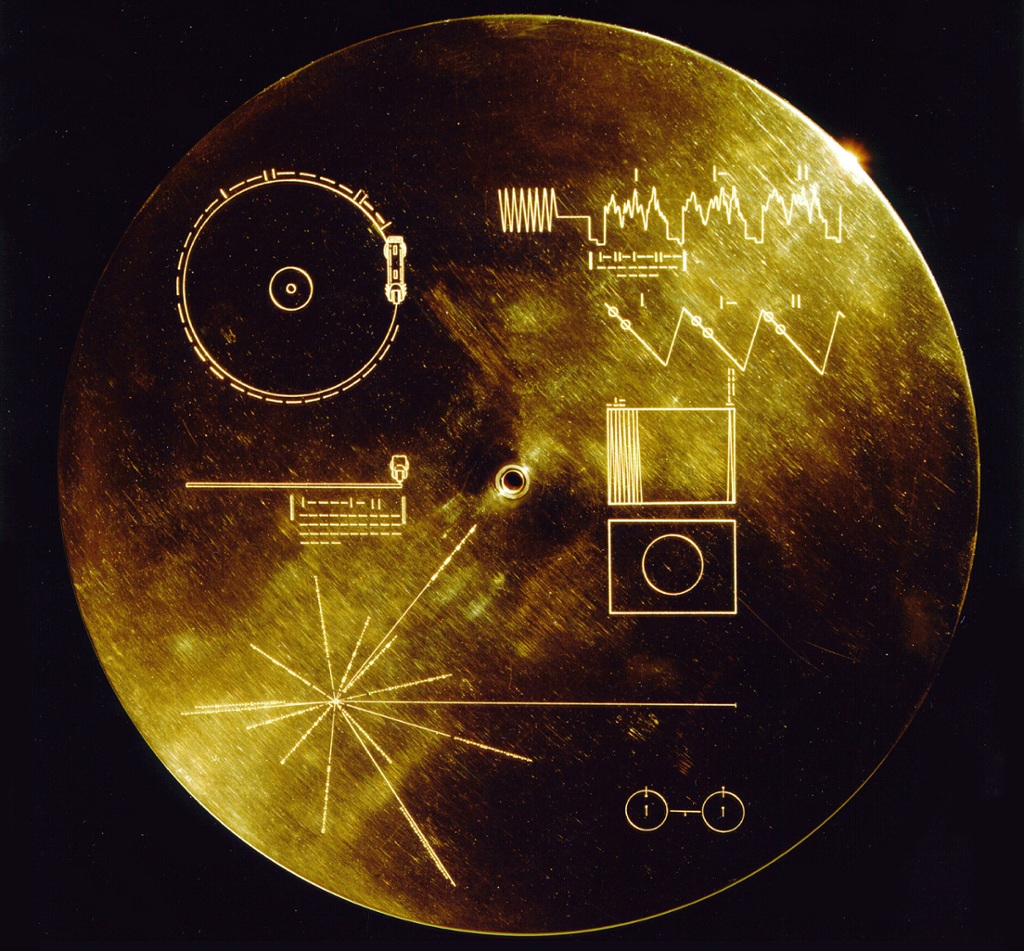
NASA “golden record,” 1977
I found watching the video slideshow of these images (presented in the order in which the record would deliver them) a deeply surreal experience. Not because Sagan’s committee “chose not to include images of war, poverty, disease, crime, ideology, or religion” — that falls under the sensible heading “put your best foot forward” and/or “don’t wash your dirty linen in interstellar space.” Simply because the selection and sequencing strike me as curious, and, if I experience them that way, what would a sentient being with no knowledge of life on this blue marble make of them?
A cluster of the images represent instructional and informational material: formulae, schematics, diagrams. The remainder consists of photographic images, a few of them by names familiar to me: Ansel Adams, Peter Beard, Phillip Leonian, David Doubilet, Brian Seed. Most of them strike me as, to put it kindly, mediocre; whoever selected them, it wasn’t an experienced picture editor. Which doesn’t matter; we didn’t send the Voyagers out to instruct other life forms on the history of photography. As a whole, they constitute an upbeat if unexciting mini-version of Steichen’s 1955 epic, “The Family of Man.”
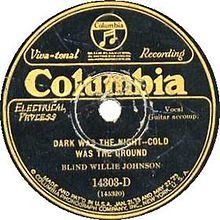
Blind Willie Johnson, “Dark Was the Night” (1927)
Making the whole thing more bizarre, the video uses for its soundtrack one of the pieces of music included on the “golden record”: Blind Willie Johnson’s eerie, wordless moan, “Dark Was the Night, Cold Was the Ground.” According to Sagan, the NASA committee chose this gospel-blues number, recorded in 1927, because they found it “haunting and expressive of a kind of cosmic loneliness.”
To see the slideshow and listen to its soundtrack, go to “The 116 photos NASA picked to explain our world to aliens,” by Joss Fong, published at Vox on November 11, 2015. You can find lists of the individual items at NASA’s website.
The “golden record” also includes a message from then-President Jimmy Carter, which reads, in part,
“We cast this message into the cosmos … Of the 200 billion stars in the Milky Way galaxy, some — perhaps many — may have inhabited planets and spacefaring civilizations. If one such civilization intercepts Voyager and can understand these recorded contents, here is our message:
This is a present from a small distant world, a token of our sounds, our science, our images, our music, our thoughts and our feelings. We are attempting to survive our time so we may live into yours. We hope someday, having solved the problems we face, to join a community of galactic civilizations. This record represents our hope and our determination, and our good will in a vast and awesome universe.”

NASA Voyager slideshow, 1977 (video screenshot)
I’m reminded of Glenn Gould’s tale of his interview with conductor Leopold Stokowski in December 1969, intended for a CBC radio program. (The polymathic Gould was born in raised in Toronto; CBC is the Canadian counterpart of the U.K.’s BBC.) Gould began the interview by asking Stokowski what he would tell an alien civilization about “the ‘artistic’ manifestations of our world.” Stokowski looked hard at him for a minute, then commenced, “Think of our solar system, its colossal size, its possibilities. …”
I doubt that he had in mind, at that moment, a woman licking a chocolate ice-cream cone, a middle-aged guy with male pattern baldness biting into a grilled-cheese sandwich, and a dude drinking from a bota, but who knows?
You’ll find the Gould story as the concluding episode of “Stokowski in Six Scenes,” published — perhaps not coincidentally — in 1977, the year of the Voyager launches. Reprinted in The Glenn Gould Reader (Vintage Books, 1990), highly recommended in its entirety, not only for Gould’s insights into matters musical but for the breadth of his intelligence, the scope of his learning, and the sheer pleasures of the text.
Ceci N’est Pas General Tso’s Chicken
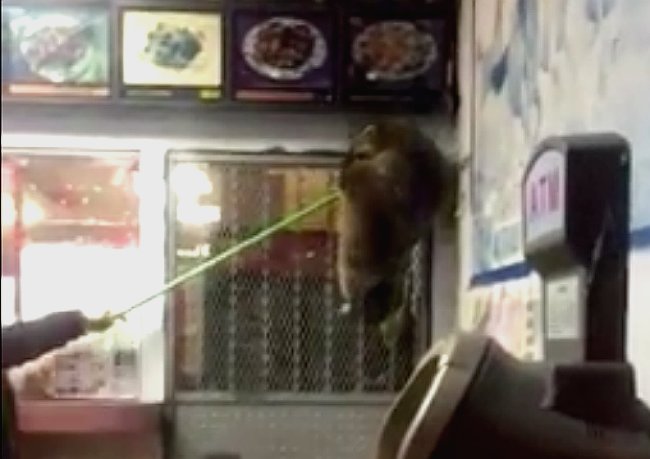
Raccoons in Chinese restaurant, Bronx, NY, January 2016
A video that went viral shows two hungry raccoons in a Chinese restaurant in the Bronx, with someone trying to shoo them away using a broom. The thing is, they’re not sneaking into the kitchen or the supply room. They’re climbing the wall of the service counter, seemingly attracted by the pictures of food hung there.
So either they actually wanted one or more of the pictures as winter decor for their den, or they had made the fundamental mistake so many make in their relation to lens-derived images: The photograph of a thing is not the thing itself.
Lectures I Can’t Wait to Watch on YouTube
“The little-known photography’s ‘art market’: Alfred Steglitz (sic), Germans & Jews,” delivered on October 19, 2015 by Michael Berkowitz, Professor of Modern Jewish History, Department of Hebrew & Jewish Sutdies (sic), University College, London. The published synopsis:
It is now common for photographs to be purchased or auctioned for hundreds of thousands of dollars. Photography emerged in the mid-19th century, but regarding photographers as artists was strongly challenged until quite recently. When did photography achieve a status near to that of painting, sculpture, and other creative arts?
The art market in photography typically is seen as beginning when the Getty paid five million dollars for the collection of Sam Wagstaff, featuring the work of Robert Mapplethorpe. Michael Berkowitz will explore the essential pre-history of this event, based on research conducted at the University of Arizona’s Center for Creative Photography (CCP) as a Josef Breitenbach Fellow in 2014.
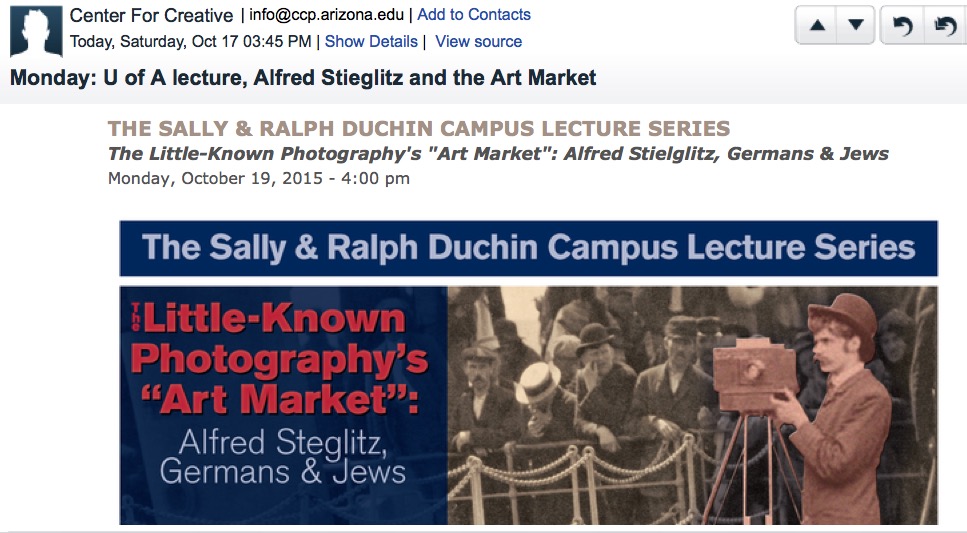
Michael Berkowitz, Stieglitz lecture, Univ. of Arizona, 10-19-15
Berkowitz’s long-term project focuses on the Jewish engagement with photography, linking the history of photography and modern Jewish history. The attempt to value photography as art was championed initially by Alfred Stieglitz, a “Hoboken Jew” trained as a photographer in Germany. Stieglitz was arguably the world’s greatest photographer, whose career is richly documented in the collections of the CCP. Josef Breitenbach, also featured in the CCP, was an emigre to the United States from Nazi Germany, and was central in the development of photography’s art market.
Consideration of the ongoing significance of Stieglitz, and the lesser-known exploits of Breitenbach, reveals the background to photography’s boom from the 1970s onward. While seeing photography as art is largely taken for granted, it possesses a complex transnational history in which Jewish difference played a critical role.
Breitenbach’s involvement in “the little-known photography’s ‘art market'” will come as news to many, not just yours truly. Especially fascinating because, from personal experience, I knew Wagstaff and Mapplethorpe as rabid anti-semites.
Another County Heard From
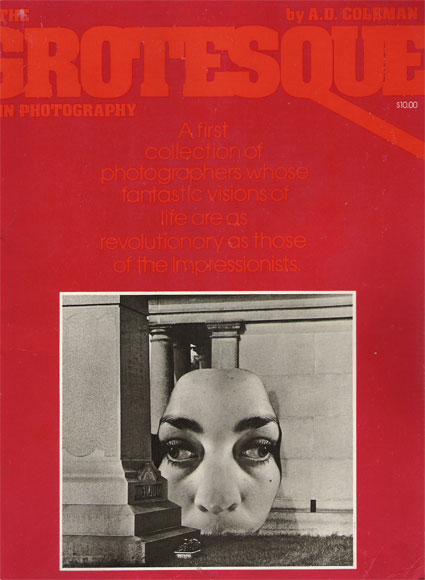 I don’t plan to attend the 2016 Society for Photographic Education National Conference in April in Las Vegas. But I do note with interest its theme, “Constructed Realities,” to indicate the gathering’s emphasis on staged imagery. As it happens, I gave that very title to the chapter on directorial work in my 1977 critical survey The Grotesque in Photography — a book that the SPE’s journal, Exposure, couldn’t trouble itself to review. Nice to see them catching up, 40 years later.
I don’t plan to attend the 2016 Society for Photographic Education National Conference in April in Las Vegas. But I do note with interest its theme, “Constructed Realities,” to indicate the gathering’s emphasis on staged imagery. As it happens, I gave that very title to the chapter on directorial work in my 1977 critical survey The Grotesque in Photography — a book that the SPE’s journal, Exposure, couldn’t trouble itself to review. Nice to see them catching up, 40 years later.
So I’m honored by SPE yet again, this time in absentia.
•
 Special offer: If you want me to either continue pursuing a particular subject or give you a break and (for one post) write on a topic — my choice — other than the current main story, make a donation of $50 via the PayPal widget below, indicating your preference in a note accompanying your donation. I’ll credit you as that new post’s sponsor, and link to a website of your choosing. Include a note with your snail-mail address (or email it to me separately) for a free signed copy of my 1995 book Critical Focus!
Special offer: If you want me to either continue pursuing a particular subject or give you a break and (for one post) write on a topic — my choice — other than the current main story, make a donation of $50 via the PayPal widget below, indicating your preference in a note accompanying your donation. I’ll credit you as that new post’s sponsor, and link to a website of your choosing. Include a note with your snail-mail address (or email it to me separately) for a free signed copy of my 1995 book Critical Focus!
Ring In the New: 2016
From a blurb for “Dikeou Superstars: Lawrence Seward” at zingmagazine‘s spinoff site, the Dikeou Collection: “We are now officially in the throws of winter.” Indeed we are. Unless I keep them cupboard my earlobs could get frostbeaten. I hear on the noose that the pitch trees down souse have loft all their believes. Gives me southpaws, let me till you. Makes me yearn for the worm weather to come, watching the hurls in their simmer tresses. [Note, February 20: I give the last word to Kanye West: “[T]here is only one thrown and that’s God’s.”]
Speaking of which: Winter has in fact arrived here, late but full force. On Sunday, January 3, I took Billie the Bengal out to back garden for a walk with me in my hoodie, perfectly comfortable for both of us. On Monday the 4th, when I stepped out the front door to run some errands, my breath frosted, and a blast of cold air slapped my face so hard I could feel my skin contracting.
They Demand Popcorn
Praying mantis with 3D glasses, courtesy Newcastle University
We have praying mantises in our garden, so this headline definitely intrigued me: “Praying mantises watch movies while wearing tiny 3-D glasses.” Seems mantises have stereo vision, and love to watch 1950s Hollywood flicks about alien invaders.
Well, I lied about the last part. But they do have stereo vision. And they do enjoy watching stereo movies about bugs. Next stop, Google Cardboard.
Another World Heard From
What do we want creatures from a distant planet, solar system, galaxy, or universe to know about us? For one answer, dating from 1977, we can turn to the “golden records” created by a committee headed by the late Carl Sagan, astronomer and science popularizer. Mounted on the outside of Voyager 1 and Voyager 2, these records contain a sampling of earthling output etched into copper LP records, including:
NASA “golden record,” 1977
I found watching the video slideshow of these images (presented in the order in which the record would deliver them) a deeply surreal experience. Not because Sagan’s committee “chose not to include images of war, poverty, disease, crime, ideology, or religion” — that falls under the sensible heading “put your best foot forward” and/or “don’t wash your dirty linen in interstellar space.” Simply because the selection and sequencing strike me as curious, and, if I experience them that way, what would a sentient being with no knowledge of life on this blue marble make of them?
A cluster of the images represent instructional and informational material: formulae, schematics, diagrams. The remainder consists of photographic images, a few of them by names familiar to me: Ansel Adams, Peter Beard, Phillip Leonian, David Doubilet, Brian Seed. Most of them strike me as, to put it kindly, mediocre; whoever selected them, it wasn’t an experienced picture editor. Which doesn’t matter; we didn’t send the Voyagers out to instruct other life forms on the history of photography. As a whole, they constitute an upbeat if unexciting mini-version of Steichen’s 1955 epic, “The Family of Man.”
Blind Willie Johnson, “Dark Was the Night” (1927)
Making the whole thing more bizarre, the video uses for its soundtrack one of the pieces of music included on the “golden record”: Blind Willie Johnson’s eerie, wordless moan, “Dark Was the Night, Cold Was the Ground.” According to Sagan, the NASA committee chose this gospel-blues number, recorded in 1927, because they found it “haunting and expressive of a kind of cosmic loneliness.”
To see the slideshow and listen to its soundtrack, go to “The 116 photos NASA picked to explain our world to aliens,” by Joss Fong, published at Vox on November 11, 2015. You can find lists of the individual items at NASA’s website.
The “golden record” also includes a message from then-President Jimmy Carter, which reads, in part,
“We cast this message into the cosmos … Of the 200 billion stars in the Milky Way galaxy, some — perhaps many — may have inhabited planets and spacefaring civilizations. If one such civilization intercepts Voyager and can understand these recorded contents, here is our message:
This is a present from a small distant world, a token of our sounds, our science, our images, our music, our thoughts and our feelings. We are attempting to survive our time so we may live into yours. We hope someday, having solved the problems we face, to join a community of galactic civilizations. This record represents our hope and our determination, and our good will in a vast and awesome universe.”
NASA Voyager slideshow, 1977 (video screenshot)
I’m reminded of Glenn Gould’s tale of his interview with conductor Leopold Stokowski in December 1969, intended for a CBC radio program. (The polymathic Gould was born in raised in Toronto; CBC is the Canadian counterpart of the U.K.’s BBC.) Gould began the interview by asking Stokowski what he would tell an alien civilization about “the ‘artistic’ manifestations of our world.” Stokowski looked hard at him for a minute, then commenced, “Think of our solar system, its colossal size, its possibilities. …”
I doubt that he had in mind, at that moment, a woman licking a chocolate ice-cream cone, a middle-aged guy with male pattern baldness biting into a grilled-cheese sandwich, and a dude drinking from a bota, but who knows?
You’ll find the Gould story as the concluding episode of “Stokowski in Six Scenes,” published — perhaps not coincidentally — in 1977, the year of the Voyager launches. Reprinted in The Glenn Gould Reader (Vintage Books, 1990), highly recommended in its entirety, not only for Gould’s insights into matters musical but for the breadth of his intelligence, the scope of his learning, and the sheer pleasures of the text.
Ceci N’est Pas General Tso’s Chicken
Raccoons in Chinese restaurant, Bronx, NY, January 2016
A video that went viral shows two hungry raccoons in a Chinese restaurant in the Bronx, with someone trying to shoo them away using a broom. The thing is, they’re not sneaking into the kitchen or the supply room. They’re climbing the wall of the service counter, seemingly attracted by the pictures of food hung there.
So either they actually wanted one or more of the pictures as winter decor for their den, or they had made the fundamental mistake so many make in their relation to lens-derived images: The photograph of a thing is not the thing itself.
Lectures I Can’t Wait to Watch on YouTube
“The little-known photography’s ‘art market’: Alfred Steglitz (sic), Germans & Jews,” delivered on October 19, 2015 by Michael Berkowitz, Professor of Modern Jewish History, Department of Hebrew & Jewish Sutdies (sic), University College, London. The published synopsis:
It is now common for photographs to be purchased or auctioned for hundreds of thousands of dollars. Photography emerged in the mid-19th century, but regarding photographers as artists was strongly challenged until quite recently. When did photography achieve a status near to that of painting, sculpture, and other creative arts?
The art market in photography typically is seen as beginning when the Getty paid five million dollars for the collection of Sam Wagstaff, featuring the work of Robert Mapplethorpe. Michael Berkowitz will explore the essential pre-history of this event, based on research conducted at the University of Arizona’s Center for Creative Photography (CCP) as a Josef Breitenbach Fellow in 2014.
Michael Berkowitz, Stieglitz lecture, Univ. of Arizona, 10-19-15
Berkowitz’s long-term project focuses on the Jewish engagement with photography, linking the history of photography and modern Jewish history. The attempt to value photography as art was championed initially by Alfred Stieglitz, a “Hoboken Jew” trained as a photographer in Germany. Stieglitz was arguably the world’s greatest photographer, whose career is richly documented in the collections of the CCP. Josef Breitenbach, also featured in the CCP, was an emigre to the United States from Nazi Germany, and was central in the development of photography’s art market.
Consideration of the ongoing significance of Stieglitz, and the lesser-known exploits of Breitenbach, reveals the background to photography’s boom from the 1970s onward. While seeing photography as art is largely taken for granted, it possesses a complex transnational history in which Jewish difference played a critical role.
Breitenbach’s involvement in “the little-known photography’s ‘art market'” will come as news to many, not just yours truly. Especially fascinating because, from personal experience, I knew Wagstaff and Mapplethorpe as rabid anti-semites.
Another County Heard From
So I’m honored by SPE yet again, this time in absentia.
•